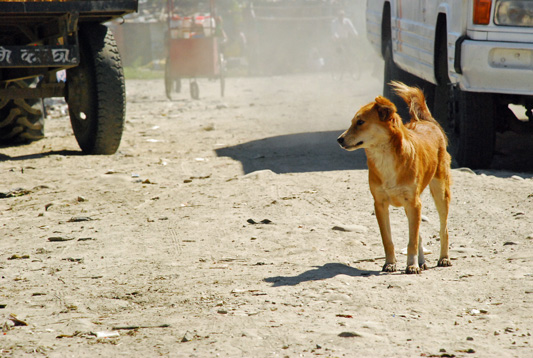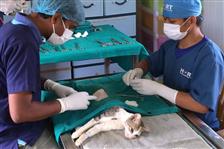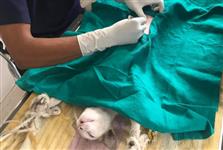
|
||
|
||
|
|
please click on photos to enlarge Street Dogs
The term 'street dogs' is widely used to describe the dogs seen largely on the streets in many developing countries. Some of them have homes but are allowed to roam around freely in their communities while others are born and live on the streets throughout their lives. The definition of pet ownership is very vague in most areas and often limited to only feeding the dogs with little regard for the other needs of the animals. Many owned dogs are abandoned by their owners because they are sick or they do not want them any more. Street dogs are prone to many diseases including mange and distemper as well as infections from untreated wounds. They are also susceptible to road traffic accidents and sometimes to malicious mistreatment.
In Nepal, most of a neighbourhood's inhabitants will recognise the individual dogs that live among them even if they choose to do no more than regard them as part of the street furniture. HART seeks out and encourages those people in the community who are concerned about their local animals and enjoy their company. Currently, information on animal care is not widely available and animal sentience is not well recognised, and so even well-meaning people can inadvertently cause their companion animals to suffer. Poisoning was used as a regular method of culling street dogs by local authorities but in recent years this has been made illegal. Although the killing of animals, particularly pups, undoubtedly continues, it is no longer accepted generally and the authorities seek to find humane alternatives. CatsThere are far fewer cats than dogs in Nepal although every town appears to have a colony. In recent years, the number of cats has increased and so has the culture of owing cats as pets. Nevertheless, most of the cats are usually wild and not used to human interactions. Cats also suffer from mange, untreated diseases and wounds and road accidents. They are often emaciated and kittens are sometimes found lost or abandoned.As with the street dogs some well-intentioned individuals take responsibility for one or more cats, though again, as with the street dogs, this does not guarantee the animals a good life. HART neuters and vaccinates as many cats as it can reach. EquinesMules, donkeys and ponies are used as pack animals in some parts of the country and as carriers in the brick kiln factories of the Kathmandu valley. HART supports Animal Nepal and AHTCS who run programmes to alleviate the situation of working equines.CattleWith a majority Hindu population, cattle are generally revered. However, bull calves and non-productive females are frequently abandoned to a life of scavenging on the streets. HART is often called on to treat or assist sick and injured cattle.Animal SacrificeThis is still widely practised throughout Nepal, both at festivals and to mark notable occasions, and it is carried out publicly. A particularly distressing festival is held in the south of Nepal every four years and called the Gadhimai. More information on this event and the campaign to mitigate, or even stop it altogether, is available at STOP Animal SacrificeCommunity HelpAs noted above there are many animal lovers in every town in Nepal. These people are the ones who will call for help for a sick or injured animal in the street and who will help nurse it back to health. They will assist in holding animals safely during vaccination campaigns. They are eager to do the best they can and they are valued and respected allies. |
|
|
Copyright © 2010-2026 Himalayan Animal Rescue Trust | All rights reserved
|
||




